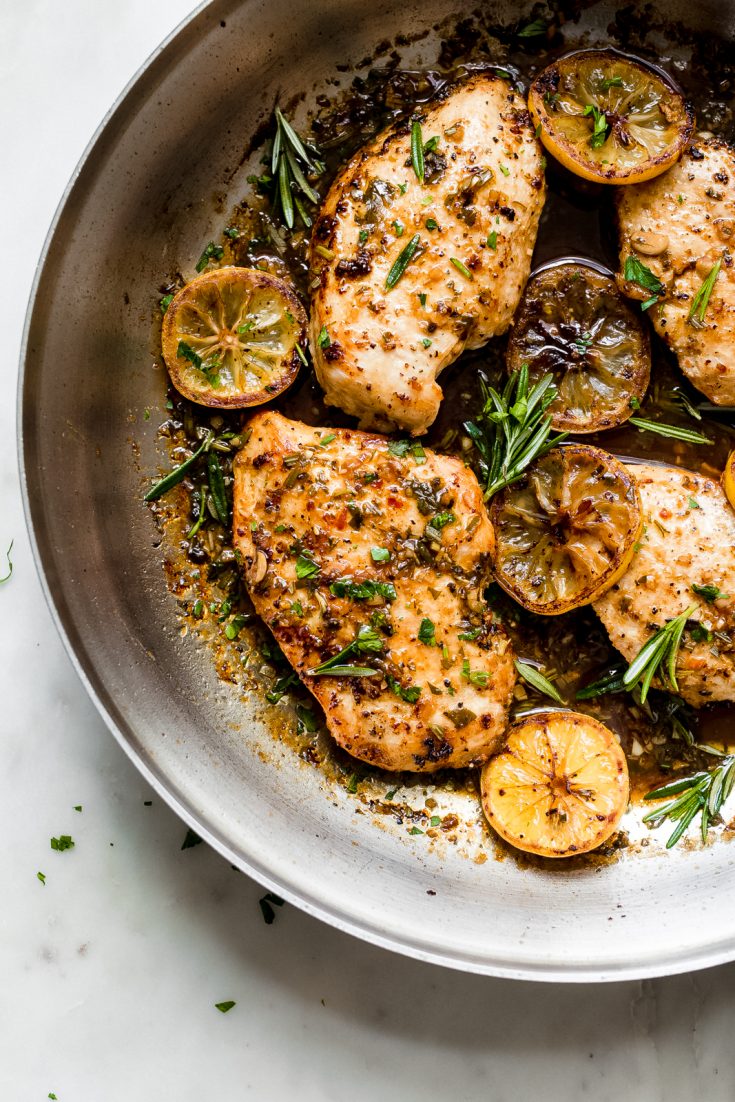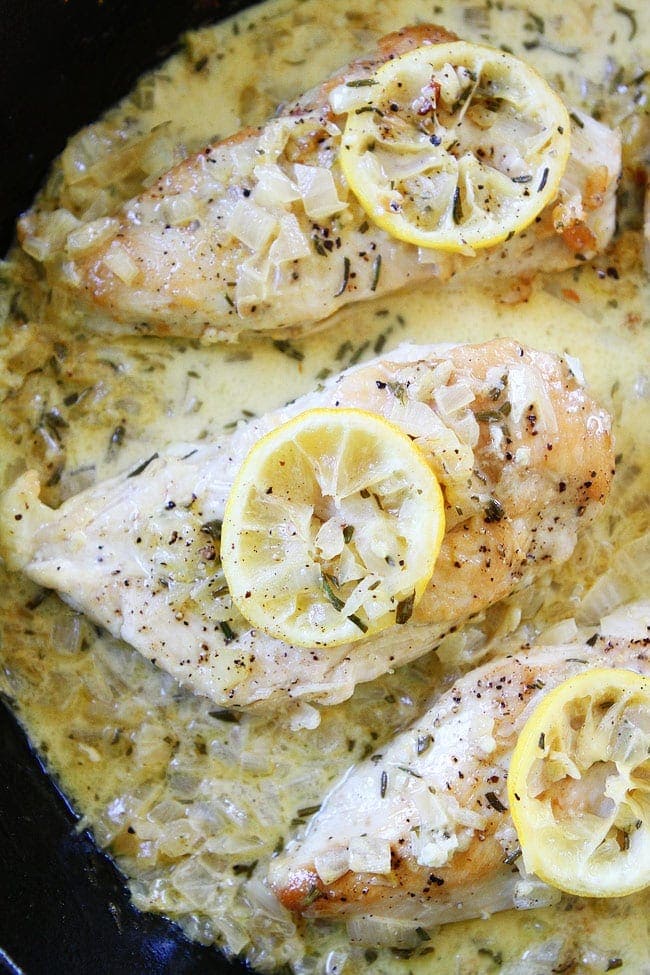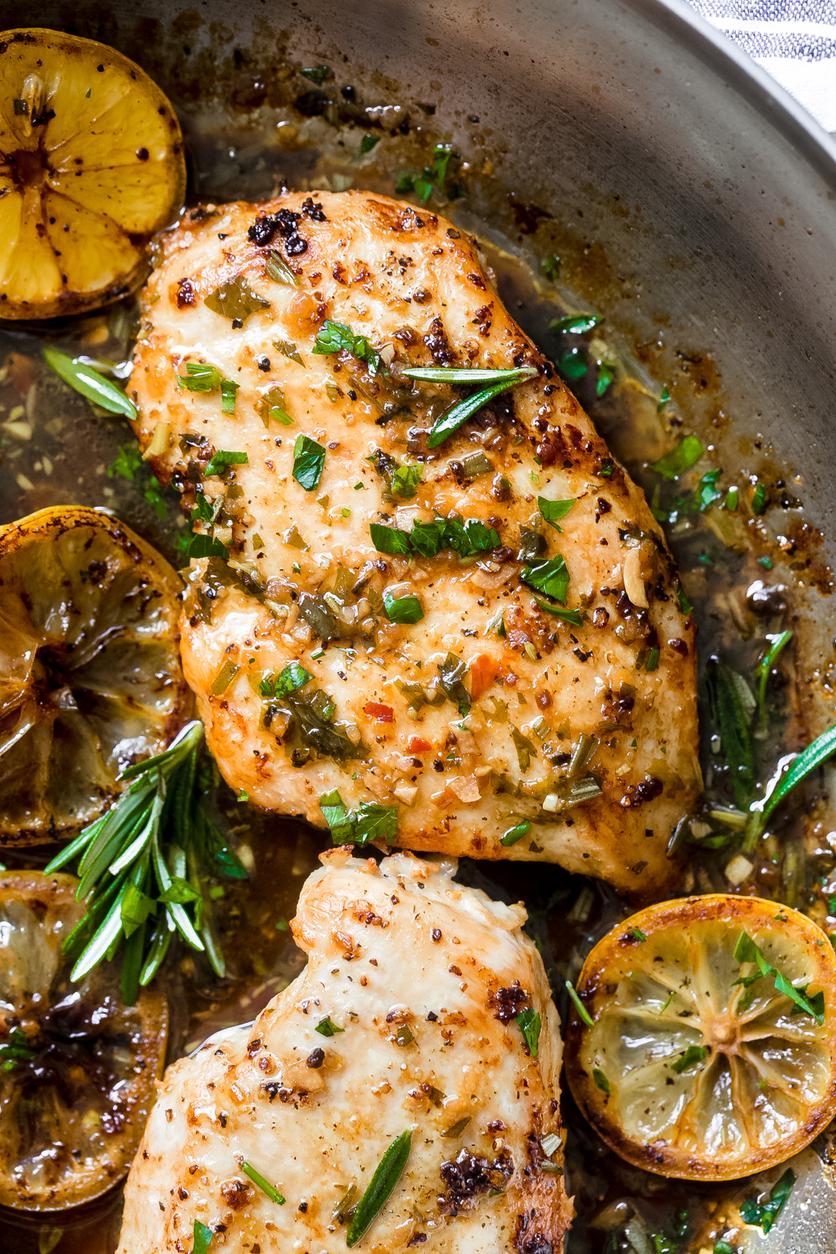Introduction: The Magic of One-Skillet Cooking
There’s a particular magic that happens when cooking becomes streamlined, when the chaos of multiple pans and splattered ingredients transforms into a simple, satisfying process. One-skillet meals aren’t just about saving time and effort; they’re about creating a more mindful and relaxed cooking experience. The core principle is beautifully simple: everything cooks together in a single pan, maximizing flavor transfer and minimizing cleanup. This method is a cornerstone of efficient weeknight dinners, particularly when you crave bold, aromatic flavors. Think about it – the juices from the chicken and vegetables mingle with the herbs and lemon, creating a concentrated sauce that coats every morsel. It’s a technique that elevates even the most basic ingredients, transforming them into a restaurant-quality dish without the fuss. The beauty also lies in the reduced stress; you’re not frantically juggling multiple cookware pieces, just gently tending to a single pan. It encourages you to slow down, savor the aromas, and truly enjoy the process of creating a delicious meal. This isn’t merely cooking; it’s about bringing a sense of calm and enjoyment to your evenings. This approach is a key to simplifying your life and elevating your culinary game – a true testament to the power of mindful cooking. Furthermore, this method allows the natural flavors of the ingredients to marry beautifully, resulting in a depth of taste that’s rarely achieved with traditional multi-pan cooking. flavor infusion, the art of maximizing the aroma and taste of food, is greatly enhanced by the collaborative cooking process that occurs in a single skillet. Efficient Cooking is an important aspect of improving our cooking skills and time management. Finally, the reduced amount of washing up is an added benefit that completes the simple cooking process. Cleaning Tips will make your life easier!
Ingredients: Aromatic Essentials for Flavor
Let’s talk about what goes into creating this incredible one-skillet lemon rosemary chicken – it’s more than just a recipe; it’s about layering flavors. The key to a truly exceptional dish lies in the quality and thoughtful combination of ingredients. We’re aiming for a vibrant, herbaceous profile, and each element plays a crucial role.
First, we have the star of the show: butter ( dairy fats). We’ll use 3 tablespoons, divided, to begin with – 2 tablespoons for searing the chicken and creating a rich, foundational flavor, and the remaining tablespoon to build a luscious, lemon-infused sauce. Don’t skimp on the butter; it adds depth and richness that’s hard to replicate.
Next, we’ll need boneless, skinless chicken thighs ( chicken thigh nutrition). These are significantly better than chicken breasts for this dish because they are denser, hold their juices better, and develop a more intense flavor during searing. They’ll also cook faster, preventing overcooking and a dry result. Approximately 6 thighs (around 680-800g) will provide generous servings.
Then, let’s introduce some aromatic complexity. Shallots ( shallots benefits) are absolutely essential. We’re using 2 medium shallots, thinly sliced, to provide a delicate onion flavor that complements the rosemary and lemon without overpowering the dish. They’re subtly sweeter and more refined than regular onions, offering a layer of nuance.
Following, we require chicken stock ( chicken stock recipe). Approximately 1 cup of low-sodium chicken stock is necessary for creating a flavorful sauce and ensuring the chicken remains moist. Homemade stock is ideal, but a good quality store-bought option will also work.
Now for the herbs! Fresh rosemary ( rosemary uses) is the cornerstone of this dish. We’ll use 1 ½ Tablespoons of finely chopped leaves – fresh is absolutely critical; dried rosemary simply cannot deliver the same aromatic intensity. Ensure you have good quality rosemary, selecting sprigs with vibrant green color and a strong, piney scent.
To brighten the flavor, we incorporate lemon ( lemon nutrition) wedges. We’ll use 1 lemon, sliced and cut into small, thin wedges, to infuse the chicken and sauce with a zesty, citrusy note. Organic lemons are preferred to avoid any potential pesticide residues. Squeezing the juice from a portion of the lemon into the sauce right at the end will elevate the flavor even further.
Finally, we season with salt and pepper ( salt and pepper benefits) to taste, adjusting the seasoning according to your preference. A pinch of black pepper will add a subtle warmth and complexity. The goal is a balanced flavor profile – bright, herbaceous, and subtly savory.
Step-by-Step Instructions: From Sear to Simmer
Let’s transform a simple weeknight into a culinary delight with this step-by-step guide to our One Skillet Lemon Rosemary Chicken. It’s more than just a recipe; it’s about building layers of flavor, starting with a beautiful sear and culminating in a fragrant, simmered sauce. Preparation takes just a few minutes, but the payoff is a truly exceptional meal.
Step 1: The Initial Sear – Building Flavor Foundations
Begin by heating 2 tablespoons of butter in a large skillet over medium-high heat. Allow the butter to melt completely, swirling the pan occasionally to ensure even coverage. This initial step is crucial – it’s where we build the foundation of our flavor. Don’t rush this; you want a nice, even melt, not a burn. Once melted, season the 6 boneless, skinless chicken thighs generously with salt and freshly ground black pepper. The salt will draw out moisture, leading to a better sear, while the pepper adds a welcome kick. Carefully add the chicken thighs to the hot skillet, ensuring they aren’t overcrowded. Overcrowding will lower the pan temperature, preventing a proper sear. Cook for approximately 4-5 minutes per side, until the chicken is golden brown and releases easily from the bottom of the pan. This indicates a successful sear – the color is beautiful, and the chicken isn’t sticking. *The trick here isn’t just to cook the chicken; it’s to let it *brown. Patience is key – resist the urge to move the chicken around before it’s nicely browned. A good sear creates Maillard reaction, a chemical reaction that develops complex, savory flavors. Transfer the seared chicken thighs to a plate, cover them loosely with foil, and keep them warm while we prepare the aromatics.
Step 2: Aromatic Infusion – Shallots and Rosemary
Reduce the heat to medium and add the remaining 1 tablespoon of butter to the skillet. Once melted, add 2 medium shallots, thinly sliced. Sauté the shallots, stirring frequently, for about 4-5 minutes, until they soften and become translucent, and begin to lightly brown. This gentle sautéing is where the shallots release their delicate sweetness and start to build the aromatic base for our dish. Next, add 1 ½ tablespoons of finely chopped fresh rosemary. Stir constantly for another minute, allowing the rosemary to bloom and release its herbaceous oils. This brief stir ensures the rosemary’s volatile oils are captured, maximizing their flavor impact. The combination of butter, shallots, and rosemary is the heart of our lemon-rosemary flavor profile.
Step 3: Building the Sauce – Stock and Reduction
Pour in 1 cup of chicken stock. Increase the heat to medium-high, and bring the stock to a gentle boil. Using a spatula or wooden spoon, scrape the bottom of the pan vigorously. This is a critical step – you’re looking to deglaze the pan, lifting all the browned bits (the fond) from the bottom. These browned bits are packed with concentrated flavor, and scraping them into the stock is where much of the deliciousness resides. Allow the stock to come to a boil, then reduce the heat back to medium-high and let it simmer for about 4-5 minutes, stirring occasionally. As the stock reduces, the flavor intensifies, creating a luscious, flavorful sauce. The goal here is to reduce the stock by about half, concentrating the flavors and thickening the sauce slightly.
Step 4: Combining and Simmering – Finishing the Dish
Return the seared chicken thighs and any accumulated juices to the skillet. Add 6 thin slices of lemon, including the skin (organic lemons are preferred for this reason), and cover the skillet. Reduce the heat to medium-low, and simmer for 10-12 minutes, or until the chicken is cooked through (internal temperature reaches 165°F/74°C using an instant-read thermometer) and the broccoli is crisp-tender. The lemon skin infuses a bright citrus note into the sauce, while the simmering ensures the chicken is cooked thoroughly and the flavors have fully melded together. Stir gently every few minutes to prevent sticking and to ensure even cooking.
Step 5: Serving – The Final Touch
Remove the skillet from the heat. Season with additional salt and freshly ground black pepper, to taste. Serve the One Skillet Lemon Rosemary Chicken immediately. Drizzle a spoonful of the pan sauce over each chicken thigh, and garnish with additional lemon wedges, if desired. This final touch adds a burst of brightness and aroma, elevating the dish to a truly memorable experience.
Tips & Techniques: Mastering the Rosemary Lemon Flavor
To truly elevate this One Skillet Lemon Rosemary Chicken, it’s not just about following the recipe – it’s about understanding why each step matters. The magic lies in building layers of flavor, and it starts with the aromatics. Let’s dive deeper.
Choosing Your Rosemary: Fresh rosemary is absolutely crucial. Dried rosemary simply doesn’t deliver the same vibrant, piney fragrance and nuanced flavor. Look for rosemary with vibrant green needles and a strong scent – that’s a sign of freshness. Before chopping, gently crush the rosemary sprigs with the flat of your knife. This releases the essential oils, intensifying the flavor. Don’t over-bruise it, though, as this can make the flavor bitter.
The Sear is Key: The initial sear of the chicken thighs is arguably the most important step. It’s not just about browning the outside; it’s about creating a beautiful crust that carries the rosemary and lemon flavors as it crisps up. Make sure your skillet is really hot before adding the chicken, and don’t overcrowd it. Working in batches will ensure a proper sear. Pat the chicken thighs dry with paper towels before searing—this helps achieve that golden-brown color and prevents steaming.
Building the Lemon-Rosemary Sauce: Once the chicken is seared, deglazing the pan with a little white wine (optional, but adds wonderful depth) before adding the chicken stock is a critical step. This is where you lift all those flavorful browned bits from the bottom of the pan – that’s the fond – and transform them into a luscious sauce. Scrape up every last bit with a wooden spoon or spatula, really incorporating the fond into the liquid. The slight acidity of the lemon juice, combined with the rosemary and stock, creates a wonderfully balanced flavor profile.
Managing the Reduce: When reducing the sauce, don’t rush it. Simmering gently allows the flavors to meld and concentrate, resulting in a thicker, more intense sauce. Stir occasionally to prevent sticking and burning. The key is patience – it’s better to err on the side of slightly under reduced than over-reduced, which can lead to a bitter, concentrated flavor.
Lemon Selection Matters: Using organic lemons is highly recommended, especially when the skin is left on. The zest (the outermost layer) contains a higher concentration of oils and compounds responsible for the lemon’s bright flavor. Also, the pith (the white part under the zest) can be slightly bitter, so leaving the skin on minimizes this potential bitterness. If you do remove the skin, be sure to zest the lemons very finely to avoid overwhelming the flavor.
Don’t Overcook the Broccoli: The broccoli should be crisp-tender – that means it’s cooked through but still retains a slight bite. Overcooked broccoli will become mushy and lose its vibrant color and texture. Adding the frozen broccoli towards the end of cooking helps to maintain its crispness. Frozen vegetables are generally more consistently sized and cooked compared to fresh ones.
By following these tips, you’ll unlock the full potential of this One Skillet Lemon Rosemary Chicken, creating a truly exceptional weeknight meal. For more tips on cooking chicken
FAQs: Your Questions Answered
Let’s address some common questions about this fantastic One Skillet Lemon Rosemary Chicken. It’s a remarkably simple recipe, but you might still have a few lingering questions. One of the most frequent inquiries we receive is, ‘Can I really use dried rosemary?’ The short answer is no. While dried rosemary can technically be used, fresh rosemary provides a significantly brighter, more vibrant flavor that’s crucial to the success of this dish. The essential oils in fresh rosemary simply don’t translate to the same intensity when dried. Fresh rosemary nuances truly elevate the overall experience.
Another common question involves the chicken – specifically, ‘Why chicken thighs and not breasts?’ We recommend bone-in, skin-on chicken thighs for this recipe, and for a fantastic reason. Chicken breasts are notoriously prone to drying out when cooked for extended periods, especially in a one-skillet setting. The higher fat content in chicken thighs helps keep them moist and juicy. Plus, the slightly darker meat has a richer flavor that complements the lemon and rosemary beautifully. Chicken thigh moisture is key here!
People also wonder about the lemon – ‘Is it necessary to remove the skin?’ While removing the lemon skin can reduce bitterness, it also strips away a significant portion of the flavor and aroma compounds. The pith, the white part just under the skin, contains a compound called limonene, which contributes a subtle, refreshing citrus note. Leaving the skin on adds a little bit of complexity to the sauce and contributes to the overall aromatic profile. Organic lemon benefits are very impactful.
And what about the cooking time? ‘How do I know when the chicken is really cooked through?’ A reliable method is to use a meat thermometer. The internal temperature of the chicken should reach 165°F (74°C) for optimal safety and tenderness. Don’t rely solely on visual cues, as chicken can appear cooked on the outside while still being undercooked internally. Chicken internal temperature chart offers guidance.
Finally, several people ask, ‘Can I store leftovers and for how long?’ Properly stored, leftovers can be enjoyed within 3-4 days. To maximize freshness, allow the chicken to cool completely before sealing the container tightly. USDA food safety guidelines provides guidance.
We hope this clarifies your questions and inspires you to create this delicious One Skillet Lemon Rosemary Chicken. It’s truly a weeknight winner!
Conclusion: Enjoying Your Delicious Lemon Rosemary Chicken
This One Skillet Lemon Rosemary Chicken recipe isn’t just a meal; it’s a gateway to stress-free weeknight dinners. From the initial sear of the chicken to the final simmer of the sauce, every step is designed to be both simple and satisfying. The beauty of this dish lies in its ability to deliver intense flavor without the mountain of dishes typically associated with a truly wonderful meal. The bright, herbaceous notes of rosemary dance perfectly with the zesty freshness of lemon, creating a harmonious blend that’s undeniably comforting yet surprisingly sophisticated. It’s a dish that’s guaranteed to become a family favorite, sparking conversations around the table and creating memories that will last. And let’s be honest, who doesn’t love a recipe that actually makes cooking feel good? The crisp-tender broccoli, complementing the richness of the chicken, adds a welcome textural element, while the sauce – that glorious, fragrant reduction – elevates everything to a whole new level. This isn’t just a chicken dinner; it’s a testament to the idea that incredible food doesn’t have to be complicated or time-consuming. Simple Weeknight Meals truly can be achieved with a little bit of care and a flavorful recipe like this. Chicken Dinner Ideas are plentiful, but this one stands out for its balance of taste and convenience. Don’t just take my word for it; try it yourself and experience the magic of One-Skillet Cooking for yourself. It’s a truly rewarding experience. You’ll find that the concentrated flavors created in a single pan are far superior to those developed over a longer cooking time in a large pot. This Flavorful Recipe is a testament to that simple truth. I’m confident that this Lemon Rosemary Chicken will become a staple in your kitchen. It’s a recipe that celebrates the joy of cooking and the simple pleasure of sharing a delicious meal with loved ones. It’s a dish that’s perfect for entertaining or a cozy night in, offering both elegance and ease. And remember, the key to a successful meal is often just a few carefully chosen ingredients and a willingness to embrace the process. So, go ahead, treat yourself to this incredible Lemon Rosemary Chicken – you deserve it! Easy Chicken Recipes don’t get much better than this.
 ,
, ,
, ,
, ,
, ,
, ,
, ,
, ,
,
